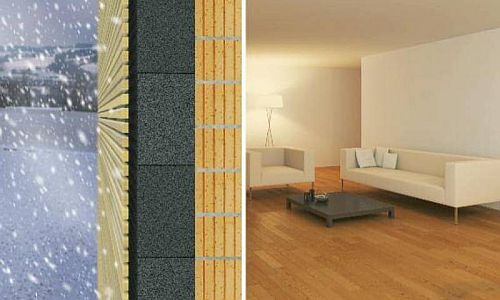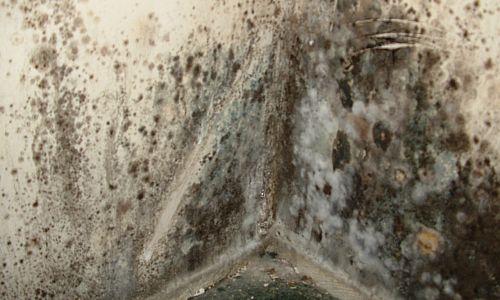Specifying FOAMGLAS® insulation to minimise condensation risk

Nearly all building products and materials allow moisture vapour to pass through them. To stop too much moisture vapour reaching cold surfaces within a construction and condensing, it is common practice to design and specify a vapour control layer (VCL) on the warm side of the thermal insulation layer.
A vapour control layer often contributes to the airtightness of the building envelope as well as its vapour tightness. Maintaining an air and vapour tight layer, in conjunction with a high level of insulation, reduces the likelihood of surface condensation occurring inside the building, or interstitial condensation occurring unseen within the building fabric.
Designing and specifying building fabric
with moisture in mind
The ‘moisture balance’ of the building fabric - in particular the external walls - should always be taken into account when specifying materials. Where refurbishment works are carried out on existing buildings, the effect of modern materials on traditional constructions may need specialist condensation risk calculations.
Differing levels of exposure to driven rain can result in varying moisture content, especially in masonry, on different sides of the same building. As well, the vapour permeability of the specified materials, the direction of moisture movement through the walls (some traditional walls actually dry into the building), and humidity levels inside the building all need to be factored in when establishing the moisture balance of a building.
As well as the question of the vapour permeability of materials and the specification of airtightness and vapour control measures, a challenge in new buildings is often allowing sufficient drying time. Construction works may have been left uncovered during heavy rain, or concrete and masonry has not been allowed to fully cure, trapping moisture within the building fabric.
How does condensation occur within building fabric?
Moisture vapour is generated inside a building by a variety of sources, including human processes (respiration and perspiration); cooking, cleaning and bathing; and the drying out of construction materials. Moisture vapour moves via the flow of warm air, or by diffusing through the building fabric.
If humid indoor air is able to penetrate the building fabric and reach the cold side of the thermal insulation layer, its temperature drops. When it reaches the dew point temperature, the air can no longer hold the same quantity of moisture vapour, and the excess moisture is deposited as condensation.
Condensation risk in industrial buildings
Where industrial buildings and equipment operate at a significantly different temperature to the ambient temperature, the risk of condensation increases.
In a low-temperature building, water vapour from the air can condense on the surface of the equipment/installation if it falls below the dewpoint. If water vapour penetrates the insulation layer, moisture between the insulation and the building envelope can cause corrosion.
The speed of corrosion doubles when the operating temperature is between 0°C and 100°C - in other words, the temperature at which water is liquid. Intermittent temperature spikes of around 15°C to 20°C can accelerate corrosion.
In industrial installations, the chemical composition of the water can also cause problems for carbon steel and stainless steel structures. Pollutants in water can leach into construction products, including insulation materials in which the pollutants form chlorides that corrode the surface of the steel.
What are the consequences of condensation in buildings?
Condensation and damp have a negative effect on the performance of the building envelope, the health of building occupants, and the efficiency and operation of equipment and processes.
Poor performing building fabric or inefficient installations increase energy consumption and costs for heating and cooling. Steel structures that become exposed to damp can rust; while pipes can corrode causing leaks, leading to safety issues, inefficiencies, and repair costs.
From a health and comfort perspective, damp and condensation can cause mould growth. Possible symptoms as a result of fungal growth include chronic coughing and sneezing, fatigue, skin irritation and persistent headaches.
Insulation solutions
for high humidity applications
Given the right conditions, condensation can occur within the floors, walls and roofs of a building. Warm, moist air comes into contact with cold surfaces and drops in temperature, reaching the dew point and depositing the excess moisture as condensation.
Buildings with high relative humidity - such as swimming pools - present particular challenges because of the greater moisture content in the air. In specialist applications, such as the petroleum, chemical, paper and food industries, the insulation layer should achieve a high level of airtightness and low vapour permeability.
Insulation must be installed to achieve a continuous unbroken layer without thermal bridges, and with a vapour control layer on the warm side of the insulation that is free of penetrations to reduce the possibility of thermal bridging.
Vapour permeability of FOAMGLAS® insulation
FOAMGLAS® cellular glass insulation is totally impervious to water vapour. The hermetically sealed, closed cell structure prevents vapour diffusion, and therefore interstitial condensation cannot occur within the insulation material.
The insulation remains dry in all conditions, helping to create safe, healthy, sustainable and thermally efficient buildings. These properties mean that FOAMGLAS® insulation is also suited to buildings with relatively high humidity levels.
FOAMGLAS® insulation has a low thermal conductivity and does not absorb liquids, making it ideal for use with stainless steel.
The benefits of FOAMGLAS® insulation in humid environments:
- No vapour barrier required.
- Impermeable to liquid water and moisture vapour.
- No internal condensation, even in areas with high relative humidity.
- Insulation remains dry throughout the year, maintaining consistent thermal performance and heat transfer.
- Dimensionally stable and will not deform, meaning no bending, swelling or shrinkage.









